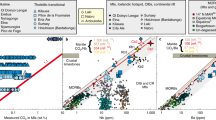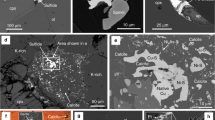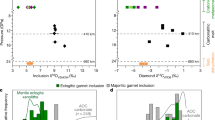Abstract
Interactions between crustal and mantle reservoirs dominate the surface inventory of volatile elements over geological time, moderating atmospheric composition and maintaining a life-supporting planet1. While volcanoes expel volatile components into surface reservoirs, subduction of oceanic crust is responsible for replenishment of mantle reservoirs2,3. Many natural, ‘superdeep’ diamonds originating in the deep upper mantle and transition zone host mineral inclusions, indicating an affinity to subducted oceanic crust4,5,6,7. Here we show that the majority of slab geotherms will intersect a deep depression along the melting curve of carbonated oceanic crust at depths of approximately 300 to 700 kilometres, creating a barrier to direct carbonate recycling into the deep mantle. Low-degree partial melts are alkaline carbonatites that are highly reactive with reduced ambient mantle, producing diamond. Many inclusions in superdeep diamonds are best explained by carbonate melt–peridotite reaction. A deep carbon barrier may dominate the recycling of carbon in the mantle and contribute to chemical and isotopic heterogeneity of the mantle reservoir.
This is a preview of subscription content, access via your institution
Access options
Subscribe to this journal
Receive 51 print issues and online access
$199.00 per year
only $3.90 per issue
Buy this article
- Purchase on Springer Link
- Instant access to full article PDF
Prices may be subject to local taxes which are calculated during checkout




Similar content being viewed by others
References
Zahnle, K. et al. Emergence of a habitable planet. Space Sci. Rev. 129, 35–78 (2007)
Sleep, N. H. & Zhanle, K. Carbon dioxide cycling and implications for climate on ancient Earth. J. Geophys. Res. 106, 1373–1399 (2001)
Dasgupta, R. & Hirschmann, M. M. The deep carbon cycle and melting in Earth’s interior. Earth Planet. Sci. Lett. 298, 1–13 (2010)
Harte, B. Diamond formation in the deep mantle: the record of mineral inclusions and their distribution in relation to mantle dehydration zones. Mineral. Mag. 74, 189–215 (2010)
Stachel, T. Diamonds from the asthenosphere and the transition zone. Eur. J. Mineral. 13, 883–892 (2001)
Thomson, A. R. et al. Origin of sub-lithospheric diamonds from the Juina-5 kimberlite (Brazil): constraints from carbon isotopes and inclusion compositions. Contrib. Mineral. Petrol. 168, 1081 (2014)
Bulanova, G. et al. Mineral inclusions in sublithospheric diamonds from Collier 4 kimberlite pipe, Juina, Brazil: subducted protoliths, carbonated melts and primary kimberlite magmatism. Contrib. Mineral. Petrol. 160, 489–510 (2010)
Shilobreeva, S., Martinez, I., Busigny, V., Agrinier, P. & Laverne, C. Insights into C and H storage in the altered oceanic crust: results from ODP/IODP Hole 1256D. Geochim. Cosmochim. Acta 75, 2237–2255 (2011)
Alt, J. & Teagle, D. The uptake of carbon during alteration of ocean crust. Geochim. Cosmochim. Acta 63, 1527–1535 (1999)
Debret, B. et al. Redox state of iron during high-pressure serpentinite dehydration. Contrib. Mineral. Petrol. 169, 36 (2015)
Kerrick, D. M. & Connolly, J. A. D. Metamorphic devolatilization of subducted mid-ocean ridge metabasalts: implications for seismicity, arc magmatism and volatile recycling. Earth Planet. Sci. Lett. 189, 19–29 (2001)
Poli, S., Franzolin, E., Fumagalli, P. & Crottini, A. The transport of carbon and hydrogen in subducted oceanic crust: an experimental study to 5 GPa. Earth Planet. Sci. Lett. 278, 350–360 (2009)
Shcheka, S. S., Wiedenbeck, M., Frost, D. J. & Keppler, H. Carbon solubility in mantle minerals. Earth Planet. Sci. Lett. 245, 730–742 (2006)
Ghosh, S., Ohtani, E., Litasov, K. & Terasaki, H. Solidus of carbonated peridotite from 10 to 20 GPa and origin of magnesiocarbonatite melt in the Earth’s deep mantle. Chem. Geol. 262, 17–28 (2009)
Stagno, V., Ojwang, D. O., McCammon, C. A. & Frost, D. J. The oxidation state of the mantle and the extraction of carbon from Earth’s interior. Nature 493, 84–88 (2013)
Kiseeva, E. S. et al. Metapyroxenite in the mantle transition zone revealed from majorite inclusions in diamonds. Geology 41, 883–886 (2013)
Ickert, R. B., Stachel, T., Stern, R. A. & Harris, J. W. Extreme 18O-enrichment in majorite constrains a crustal origin of transition zone diamonds. Geochem. Persp. Lett. 1, 65–74 (2015)
Walter, M. J. et al. Primary carbonatite melt from deeply subducted oceanic crust. Nature 454, 622–625 (2008)
Kiseeva, E. S., Litasov, K. D., Yaxley, G. M., Ohtani, E. & Kamenetsky, V. S. Melting and phase relations of carbonated eclogite at 9–21 GPa and the petrogenesis of alkali-rich melts in the deep mantle. J. Petrol. 54, 1555–1583 (2013)
Expedition 309/312 Scientists. Site 1256. In Superfast Spreading Rate Crust 2 and 3 (eds Teagle, D. A. H. et al.) Vol. 309/312 of Proc. IODPhttp://dx.doi.org/10.2204/iodp.proc.309312.103.2006 (Integrated Ocean Drilling Program Management International, Inc., 2006)
Gale, A., Dalton, C. A., Langmuir, C. H., Su, Y. & Schilling, J.-G. The mean composition of ocean ridge basalts. Geochem. Geophys. Geosyst. 14, 489–518 (2013)
Martin, A. M., Laporte, D., Koga, K. T., Kawamoto, T. & Hammouda, T. Experimental study of the stability of a dolomite + coesite assemblage in contact with peridotite: implications for sediment-mantle interaction and diamond formation during subduction. J. Petrol. 53, 391–417 (2012)
Luth, R. W. Experimental determination of the reaction aragonite + magnesite = dolomite at 5 to 9 GPa. Contrib. Mineral. Petrol. 141, 222–232 (2001)
Okamoto, K. & Maruyama, S. The Eclogite–Garnetite transformation in the MORB + H2O system. Phys. Earth Planet. Inter. 146, 283–296 (2004)
Litasov, K., Shatskiy, A., Ohtani, E. & Yaxley, G. Solidus of alkaline carbonatite in the deep mantle. Geology 41, 79–82 (2013)
Syracuse, E. M., van Keken, P. E. & Abers, G. A. The global range of subduction zone thermal models. Phys. Earth Planet. Inter. 183, 73–90 (2010)
Hammouda, T. & Laporte, D. Ultrafast mantle impregnation by carbonatite melts. Geology 28, 283–285 (2000)
Rohrbach, A. & Schmidt, M. W. Redox freezing and melting in the Earth’s deep mantle resulting from carbon–iron redox coupling. Nature 472, 209–212 (2011)
Brey, G. P., Bulatov, V., Girnis, A., Harris, J. W. & Stachel, T. Ferropericlase—a lower mantle phase in the upper mantle. Lithos 77, 655–663 (2004)
Jackson, M. G. & Dasgupta, R. Compositions of HIMU, EM1 and EM2 from global trends between radiogenic isotopes and major elements in ocean island basalts. Earth Planet. Sci. Lett. 276, 175–186 (2008)
Walter, M. J. Melting of garnet peridotite and the origin of komatiite and depleted lithosphere. J. Petrol. 39, 29–60 (1998)
Walter, M. J., Nakamura, E., Trönnes, R. G. & Frost, D. J. Experimental constraints on crystallization differentiation in a deep magma ocean. Geochim. Cosmochim. Acta 68, 4267–4284 (2004)
Watson, E., Wark, D., Price, J. & Van Orman, J. Mapping the thermal structure of solid-media pressure assemblies. Contrib. Mineral. Petrol. 142, 640–652 (2002)
Schilling, F. & Wunder, B. Temperature distribution in piston-cylinder assemblies: numerical simulations and laboratory experiments. Eur. J. Mineral. 16, 7–14 (2004)
McDade, P. et al. Pressure corrections for a selection of piston-cylinder cell assemblies. Mineral. Mag. 66, 1021–1028 (2002)
Walter, M. J., Thibault, Y., Wei, K. & Luth, R. W. Characterizing experimental pressure and temperature conditions in multi-anvil apparatus. Can. J. Phys. 73, 273–286 (1995)
Hernlund, J., Leinenweber, K., Locke, D. & Tyburczy, J. A. A numerical model for steady-state temperature distributions in solid-medium high-pressure cell assemblies. Am. Mineral. 91, 295–305 (2006)
Nakamura, K. & Kato, Y. Carbonatization of oceanic crust by the seafloor hydrothermal activity and its significance as a CO2 sink in the Early Archean. Geochim. Cosmochim. Acta 68, 4595–4618 (2004)
Coogan, L. a. & Gillis, K. M. Evidence that low-temperature oceanic hydrothermal systems play an important role in the silicate-carbonate weathering cycle and long-term climate regulation. Geochem. Geophys. Geosyst. 14, 1771–1786 (2013)
Coogan, L. a. & Dosso, S. E. Alteration of ocean crust provides a strong temperature dependent feedback on the geological carbon cycle and is a primary driver of the Sr-isotopic composition of seawater. Earth Planet. Sci. Lett. 415, 38–46 (2015)
Kelley, K. A., Plank, T., Ludden, J. & Staudigel, H. Composition of altered oceanic crust at ODP Sites 801 and 1149. Geochem. Geophys. Geosyst. 4, 6 (2003)
Hammouda, T. High-pressure melting of carbonated eclogite and experimental constraints on carbon recycling and storage in the mantle. Earth Planet. Sci. Lett. 214, 357–368 (2003)
Dasgupta, R., Hirschmann, M. M. & Withers, A. C. Deep global cycling of carbon constrained by the solidus of anhydrous carbonated eclogite under upper mantle conditions. Earth Planet. Sci. Lett. 227, 73–85 (2004)
Yaxley, G. M. & Green, D. H. Experimental demonstration of refractory carbonate-bearing eclogite and siliceous melt in the subduction regime. Earth Planet. Sci. Lett. 128, 313–325 (1994)
Dasgupta, R., Hirschmann, M. M. & Dellas, N. The effect of bulk composition on the solidus of carbonated eclogite from partial melting experiments at 3 GPa. Contrib. Mineral. Petrol. 149, 288–305 (2005)
Gerbode, C. & Dasgupta, R. Carbonate-fluxed melting of MORB-like pyroxenite at 2.9 GPa and genesis of HIMU ocean island basalts. J. Petrol. 51, 2067–2088 (2010)
Litasov, K. & Ohtani, E. The solidus of carbonated eclogite in the system CaO–Al2O3–MgO–SiO2–Na2O–CO2 to 32 GPa and carbonatite liquid in the deep mantle. Earth Planet. Sci. Lett. 295, 115–126 (2010)
Keshav, S. & Gudfinnsson, G. H. Experimentally dictated stability of carbonated oceanic crust to moderately great depths in the Earth: results from the solidus determination in the system CaO–MgO–Al2O3–SiO2–CO2 . J. Geophys. Res. 115, B05205 (2010)
Molina, J. F. & Poli, S. Carbonate stability and fluid composition in subducted oceanic crust: an experimental study on H2O–CO2 bearing basalts. Earth Planet. Sci. Lett. 176, 295–310 (2000)
Connolly, J. A. D. Computation of phase equilibria by linear programming: a tool for geodynamic modeling and its application to subduction zone decarbonation. Earth Planet. Sci. Lett. 236, 524–541 (2005)
Manning, C. E. Geochemistry: a piece of the deep carbon puzzle. Nature Geosci. 7, 333–334 (2014)
Ague, J. J. & Nicolescu, S. Carbon dioxide released from subduction zones by fluid-mediated reactions. Nature Geosci. 7, 355–360 (2014)
Manning, C. E. The chemistry of subduction-zone fluids. Earth Planet. Sci. Lett. 223, 1–16 (2004)
Newton, R. C. & Manning, C. E. Quartz solubility in H2O–NaCl and H2O–CO2 solutions at deep crust-upper mantle pressures and temperatures: 2–15 kbar and 500–900 °C. Geochim. Cosmochim. Acta 64, 2993–3005 (2000)
Newton, R. C. & Manning, C. E. Solubility of enstatite + forsterite in H2O at deep crust/upper mantle conditions: 4 to 15 kbar and 700 to 900 °C. Geochim. Cosmochim. Acta 66, 4165–4176 (2002)
Newton, R. C. & Manning, C. E. Thermodynamics of SiO2–H2O fluid near the upper critical end point from quartz solubility measurements at 10 kbar. Earth Planet. Sci. Lett. 274, 241–249 (2008)
Kessel, R., Schmidt, M., Ulmer, P. & Pettke, T. Trace element signature of subduction-zone fluids, melts and supercritical liquids at 120–180 km depth. Nature 437, 724–727 (2005)
Stagno, V. et al. The oxygen fugacity at which graphite or diamond forms from carbonate-bearing melts in eclogitic rocks. Contrib. Mineral. Petrol. 169, 16 (2015)
Zedgenizov, D. A., Kagi, H., Shatsky, V. S. & Ragozin, A. L. Local variations of carbon isotope composition in diamonds from São-Luis (Brazil): evidence for heterogenous carbon reservoir in sublithospheric mantle. Chem. Geol. 363, 114–124 (2014)
Acknowledgements
A.R.T. acknowledges the support of NERC grant NE/J500033/1. M.J.W. and S.C.K. acknowledge the support of NERC grant NE/J008583/1. We thank S. Kearns and B. Buse for their assistance performing electron probe microanalyses and J. Blundy for contributing ideas and expertise during discussions with the authors.
Author information
Authors and Affiliations
Contributions
A.R.T. designed, performed and analysed the experiments, gathered data from the literature and wrote the manuscript as part of his PhD studies. M.J.W. and S.C.K. provided training in experimental techniques, assisted during interpretation of results, provided advice and assisted with manuscript preparation in their roles as A.R.T.’s PhD supervisors. R.A.B. provided training and assistance with experimental techniques and sample preparation alongside contributing to the scientific content and preparation of the manuscript.
Corresponding author
Ethics declarations
Competing interests
The authors declare no competing financial interests.
Extended data figures and tables
Extended Data Figure 1 Comparison of experimental compositions with natural rocks.
a–f, ‘Fresh’ MORB rocks (red field), ALL-MORB21 (red circle), altered MORB rocks41 (pale blue circles), exhumed blueschist, greenschist and/or eclogitic rocks (yellow circles) and starting material from this (dark blue circle) and previous studies (green circles) of carbonated MORB compositions. In a, rocks altered MORB and exhumed rock compositions that fall on the Mg-Fe side of the maj–cpx join from Extended Data Fig. 5 plot below the dashed line, compositions that lie on the Ca side of this join are plotted as orange circles with yellow outlines or purple circles with blue outlines and sit above the dashed curve. This confirms that magnesite will be the stable carbonate phase at high pressure in the vast majority of natural crustal rocks, as is the case for ATCM1. Data and corresponding references for this figure are provided in the online source data file.
Extended Data Figure 2 Experimental results/phase diagram and interpreted solidus position.
The reactions clinopyroxene + CO2 = dolomite + 2coesite and dolomite = magnesite + aragonite are from refs 22 and 23 respectively. The upper left curve is the anhydrous MORB solidus. Note that due to temperature gradients in experiments at 8 GPa, a small quantity of dolomite is observed coexisting with melt in one experiment above the solidus, present at the cold end of the capsule. arag, aragonite; CM, carbonatite melt; cpx, clinopyroxene; cs, coesite; dol, dolomite; gt, garnet; mag, magnesite; maj, majoritic garnet; Na carb, Na carbonate; ox, FeTi oxide; SM, silicate melt; st, stishovite.
Extended Data Figure 3 BSE images of experimental products.
a, 7.9 GPa, 1,250 °C; b, 7.9 GPa, 1,350 °C; c, 13.1 GPa, 1,350 °C; d, 13.1 GPa; 1,450 °C; e, 20.7 GPa, 1,100 °C; f, 20.7 GPa, 1,480 °C; g, 20.7 GPa, 1,600 °C; h, sandwich experiment, 20.7 GPa, 1,400 °C. Scale bars, 10 μm. CM, carbonatite melt; cpx, clinopyroxene; dol, dolomite; FeTi, FeTi oxide; gt, garnet; mag, magnesite.
Extended Data Figure 4 Composition of experimental melts from this study.
a, b, Experimental melts from selected previous studies marked with semi-transparent greyscale symbols. b, The effects of increasing pressure, temperature and the effect of contamination due to partial analysis of silicate minerals surrounding small melt pools are shown.
Extended Data Figure 5 The composition of experimental phases from this study projected into two quaternary plots.
a, b, [Ca]-[Mg+Fe2+]-[Si+Ti]-[Na+K] (a) and [Mg+Fe2+]-[Ca]-[Al+Fe3+]-[Na+K] (b). In both diagrams the grey fields are the compositional data projected onto the basal ternary. The red field is the range of natural MORB compositions projected onto the basal ternary. The yellow star plotted in the four-component system and projected onto the basal ternary is ATCM1 (our bulk composition) while the black stars are bulk compositions from previous studies25,26,27.
Extended Data Figure 6 BSE images of reaction experiments.
a–d, G169 (a, b) and G177 (c, d). In both experiments a reaction zone and remaining carbonatite melt surrounds the unreacted peridotite region. a, An overview of G169. b, A close up of the reaction in G169 containing newly crystallized calcium perovskite, majorite, ferropericlase and ringwoodite minerals. c, A close up of the reaction products in G177, which consist of small bright calcium perovskites, new majorite that is often observed as a rim on relic peridotitic garnet and ringwoodite. d, An overview of G177. CaPv, calcium perovskite; fper, ferropericlase; maj, majorite; rw, ringwoodite; wad, wadsleyite.
Extended Data Figure 7 Raman spectra of minerals from reaction experiment G177 measured using a blue 455 cm−1 excitation laser.
The position of the main peaks in each collected spectrum have been labelled with their shift from the excitation laser in cm−1.
Extended Data Figure 8 Comparison of diamond-hosted calcium perovskite inclusions with experimental mineral compositions in MgO versus Ti number space.
Ti number = Ti/[Ca+Ti]. Data and corresponding references for this figure are provided in the online source data file.
Supplementary information
Supplementary Tables
This file contains Supplementary Tables 1-5. (XLSX 146 kb)
Rights and permissions
About this article
Cite this article
Thomson, A., Walter, M., Kohn, S. et al. Slab melting as a barrier to deep carbon subduction. Nature 529, 76–79 (2016). https://doi.org/10.1038/nature16174
Received:
Accepted:
Published:
Issue Date:
DOI: https://doi.org/10.1038/nature16174
This article is cited by
-
A critique of using epitaxial criterion to discriminate between protogenetic and syngenetic mineral inclusions in diamond
Scientific Reports (2024)
-
Deep recycling of crustal materials by the Hainan mantle plume: evidence from Zn–Sr–Nd–Pb isotopes of Hainan Island basalts
Contributions to Mineralogy and Petrology (2024)
-
Carbonate-rich crust subduction drives the deep carbon and chlorine cycles
Nature (2023)
-
Cubic Fe-bearing majorite synthesized at 18–25 GPa and 1000 °C: implications for element transport, subducted slab rheology and diamond formation
Scientific Reports (2023)
-
Pervasive hydrous carbonatitic liquids mediate transfer of carbon from the slab to the subarc mantle
Communications Earth & Environment (2023)
Comments
By submitting a comment you agree to abide by our Terms and Community Guidelines. If you find something abusive or that does not comply with our terms or guidelines please flag it as inappropriate.



